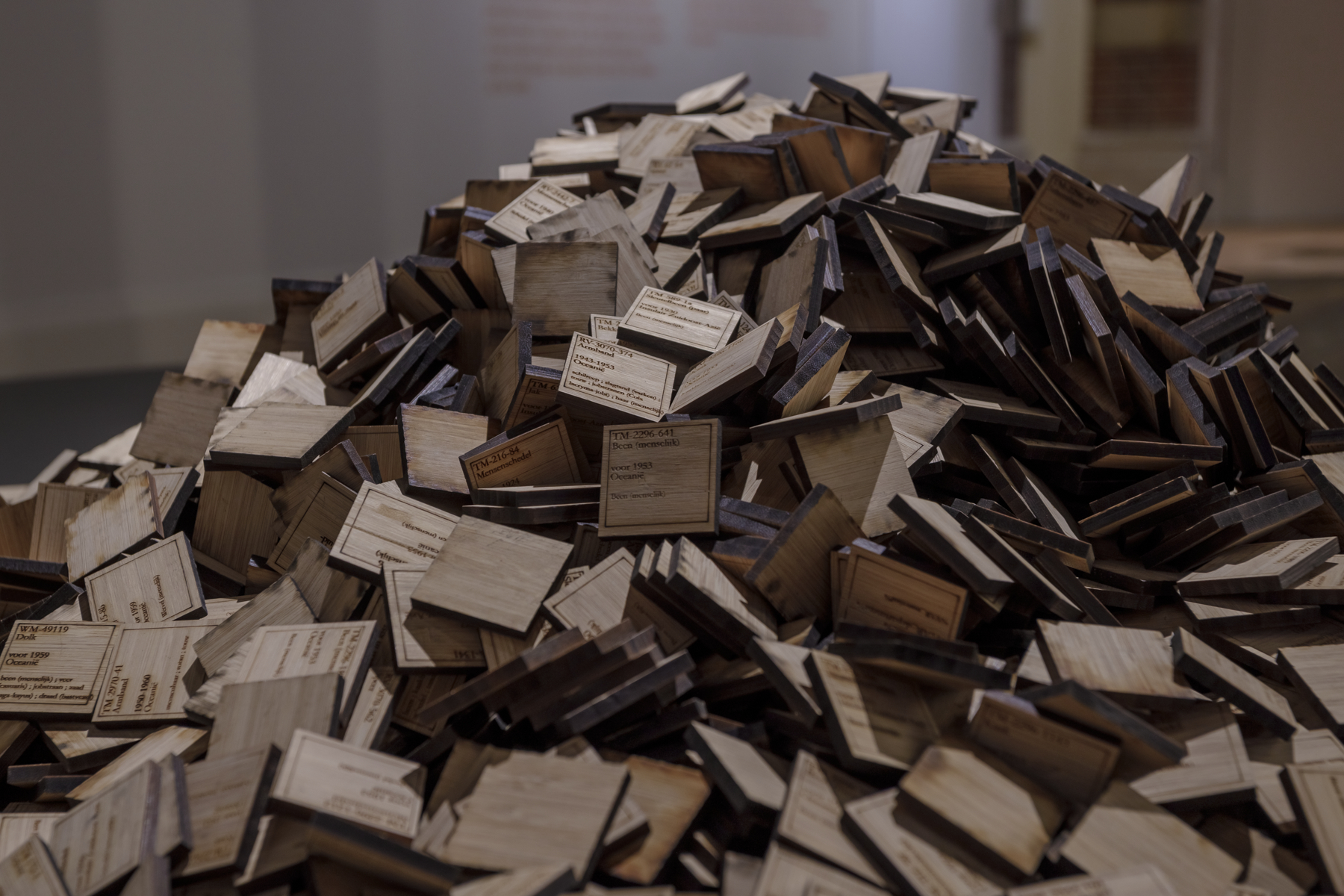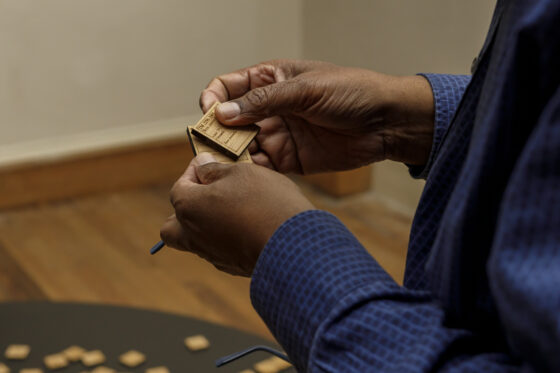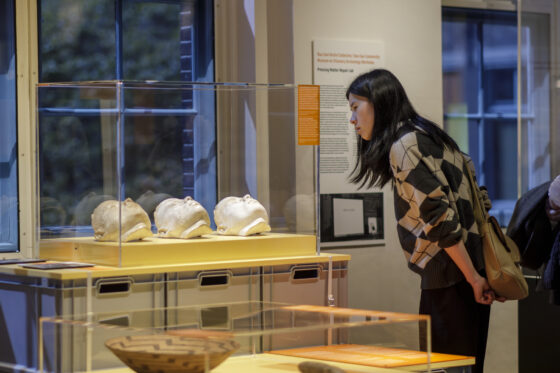Skeleton in the closet: show asks questions on colonial objects
Senay Boztas
Three human skulls lie in a row on a disk of black cloth – not the bones themselves, but small wooden tokens representing an uncomfortable part of the World Museum’s collection of human remains.
This is part of an art installation by Pansee Atta, reproducing more than 4,000 labels from this colonial-era collection of human parts and inviting visitors to the World Museum Amsterdam to “organise” them.
It is one of the most striking parts of an exhibition attempting to tackle questions of how museums should deal with artifacts and human bodies acquired during a colonial past. Some were gifted, bought or traded, often in the name of science and racial theories of the time; others were stolen or obtained illicitly. Appropriately, the new exhibition is entitled “Unfinished past: return, keep, or…?”
Wayne Modest, director of content for the World Museum, said his group of museums wanted to tackle complex issues without giving easy answers. “We are not saying that all of the objects in our collection were collected during colonialism,” he said during a press opening.
“We don’t say that all of the objects were stolen either. But we are looking at the objects that were collected during the colonial era, what it means and what sort of thoughts and ideologies informed why we collected them.”
The show is a response to a growing social pressure internationally to do something about colonial-era collections including parts of people’s bodies, from those three skulls from Middle/South America to a Surinamese newborn baby preserved in formaldehyde – as well as questions like whether museums would be empty if they gave back things people had no right to take.
“Objects came into the collection through different routes: presents, diplomatic exchange, theft, also from missionaries,” said Modest. “Sometimes it was – ‘I give you something, you give me something’ – an exchange, sometimes the exchange didn’t go right, sometimes the colonised gave objects to the colonisers…to have an influence in the colonial relation.
“We are asking big questions: what is the value of a colonial collection and for whom? The second is: who is the owner? And the last question is: is it possible to talk about reconciliation…and is restitution – giving something back – the only way reconciliation can be pursued?”

In the first room of the exhibition, one exhibit by modern artist Aram Lee reflects on the implications of museum preservation techniques that effectively poisoned objects, such as the use of DDT.
Alongside, looking out over what was once Amsterdam’s eastern cemetery, is the low table with Atta’s mass of laser-cut chips – describing collections of human hair, a thigh bone, leg bones, and the vaguest of information about who they once were.
“You can be a curator,” said Modest. “You can order what you think belongs together – which human remains belong together. You see in the game there – it is an invitation.”
The unspoken question is, of course, whether you have the right to do this – and the museum itself has pledged not to show human remains to the general public. “That’s what it’s about,” he said. “It’s what Michael Rothberg calls [being] implicated. When you begin to organise things, what does that mean for your power over them?
“And there will be people who go along with that, perhaps even unconsciously…There are also people who will say, ‘I don’t want to deal with this. This isn’t my responsibility.’ And that’s part of what we tried to explore with this exhibition. It raises the question: how do we take responsibility for pasts that we were not a part of?”

Using video, artwork and a careful selection from the museums’ 430,000 objects, the exhibition describes how they were amassed with the efforts of missionaries, curious early travellers and traders and early scientists, including those motivated by racial theories.
Thanks to the Pressing Matter research project, which traced the ancestor of a man from the Indonesian island Nias who had his face cast by Dutch anthropologist J.P. Kleiweg de Zwaan, three of his facial casts are on display, with permission.
The show questions whether items were collected within the laws of the time, if things such as human remains were repatriated, who they would be given back to, and how museums should transfer the knowledge they have about their meaning, and preservation.
Anne Marie Woorlee, who worked on creating the exhibition, said one room contains an empty glass case as a metaphor. “We’ve also said for several years now that we do not want to display human remains, no ancestral remains, in this museum,” she said. “Not in images, and not physically…They are stored in a depot, and will remain there undisturbed until [the Dutch government has] developed a policy on what to do with them. And this serves as a symbol of that.”
Give it back?
There are three positions, added Modest: give it back, because it is just; don’t give it back, because we got it correctly but also if we had not, it would not exist; and a middle position exploring what Western museums can do with local partners to explore the future of these collections.
While the Dutch government is still drawing up policy on human remains, it is a front-runner in policy to repatriate colonial items “involuntarily lost by the countries of origin”, such as hundreds of cultural artifacts returned, decades after the first request, to Indonesia and Sri Lanka in 2023 and 2024.
“There’s definitely been a shift in how we think as a society in Europe,” said Modest. “And with that shift there is still uncertainty – even angry thoughts…and part of society that says: we shouldn’t give it back because it will be destroyed or looted.
“But in our research, and in Dutch policy, we say: It’s not our role to determine what others do with returned objects. We can’t control that. The real question is, we want to know as researchers: what does it mean when an object returns?”
Insects
Sometimes, he added, objects were not meant to be preserved. Years ago, he worked with a community in Jamaica and bought a dance mask for his museum at the time. “But that created conflict in the community,” he said. “They were uncomfortable. For this community, the spirits were not allowed to leave the object because we kept it in the museum. The life cycle of the object was to disappear – it was a dance mask. At the end of the dance, the whole community would smash it so that the spirits leave.”
Just like a winter drum recently returned by the Dutch government to the Texan Ysleta del Sur Pueblo tribe, Modest said sometimes things might return to private ownership or be broken.
One journalist wondered what had happened to that dance mask. “We were busy with an exhibition about carnival and I wanted to borrow the object,” said Modest. “I sent an email… and they said to me: ‘Wayne. Sorry, but insects ate the object.’ And I thought: how poetic is that? So the object died its own death.”
Thank you for donating to DutchNews.nl.
We could not provide the Dutch News service, and keep it free of charge, without the generous support of our readers. Your donations allow us to report on issues you tell us matter, and provide you with a summary of the most important Dutch news each day.
Make a donation